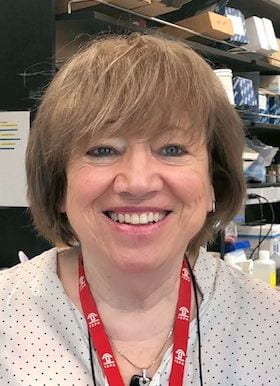
Adriana S. Dusso, PhD
Associate Professor of Medicine
- Phone: 314-747-5444
- Email: adusso@nospam.wustl.edu
Biography
Dr. Dusso is a Summa Cum Laude graduate in Biochemistry from the Universidad Nacional de Rosario, Argentina. In 1978, after a two year fellowship in Clinical Biochemistry, she joined Dr. Puche´s laboratory, in the Division of Biological Chemistry with a dual appointment: Assistant Professor of Biological Chemistry for 2nd year medical students and Ph.D. student conducting the research work for her thesis entitled “Vitamin D and iron Metabolism”. She obtained her Ph. D. degree in Biochemistry in 1984.
In 1985, she received a post-doctoral scholarship to join Dr. Slatopolsky’s laboratory, in the Renal Division at Washington University School of Medicine in St. Louis, to work on “Abnormalities in renal and extrarenal vitamin D synthesis in chronic kidney disease (CKD): Role in the development of Secondary Hyperparathyroidism”. She was appointed Faculty in 1988 and progressed through the ranks to Research Associate Professor, a position she held until June 30, 2010.
On September 1, 2010, she joined the Division of Experimental Nephrology at Lleida Institute for Biomedical Research, Lleida University in Lleida, Spain, as a Senior Investigator. In January 2015, her laboratory moved to the Bone and Mineral Research Unit, directed by Dr. Cannata-Andia, at Instituto de Investigación Sanitaria del Principado de Asturias. In Spain, her research focussed on “Vitamin D control of renal and vascular aging in CKD”.
Research Interests
Dr. Dusso´s laboratory studies molecular mechanisms that causally link abnormalities in renal and extrarenal vitamin D metabolism and actions, with the accelerated multiorgan aging increasing the high risk of cardiovascular mortality in CKD. Her laboratory has identified relevant translational pathways including: 1) Defective substrate uptake for calcitriol (the vitamin D hormone) synthesis by monocyte-macrophages in CKD, which is corrected by calcitriol administration; 2) The molecular bases that causally link the severity of parathyroid hyperplasia with reductions in vitamin D receptor (VDR) levels, causing resistance to vitamin D control of secondary hyperparathyroidism. Specifically, using pharmacological and genetic approaches, her laboratory demonstrated that vitamin D deficiency and hyperphosphatemia induce the onset of a parathyroid ADAM17-TGFα feedforward loop for EGFR activation, whose downstream signaling exacerbates growth and reduces VDR gene expression; 3) The mechanisms by which synthetic calcitriol analogs suppress secondary hyperparathyroidism with lower hypercalcemic or hyperphosphatemic episodes; 4) Synergistic parathyroid VDR activation by combined treatment with nutritional vitamin D and calcitriol (analogs) that effectively counteract the ADAM17/TGFα-driven loop for EGFR activation, while avoiding the risk of hypercalcemia and hyperphosphatemia associated with calcitriol dose escalation. Recently, her laboratory has demonstrated that the activation of an ADAM17/TNFα inflammatory loop in uremic aortas augments the release of pro-calcifying exosomes propagating medial calcium deposition. This inflammatory loop is efficaciously suppressed by dietary barley beta-glucans not only in uremic aortas but also in circulating leukocytes from healthy adults, attenuating immune senescence signaling. The current research interests focus on the identification of the earliest biomarkers of vitamin D and barley beta-glucans efficacy to safely target ADAM17 activation, with the goal of the safe design of strategies directed to attenuate immune and multiorgan aging beyond CKD.